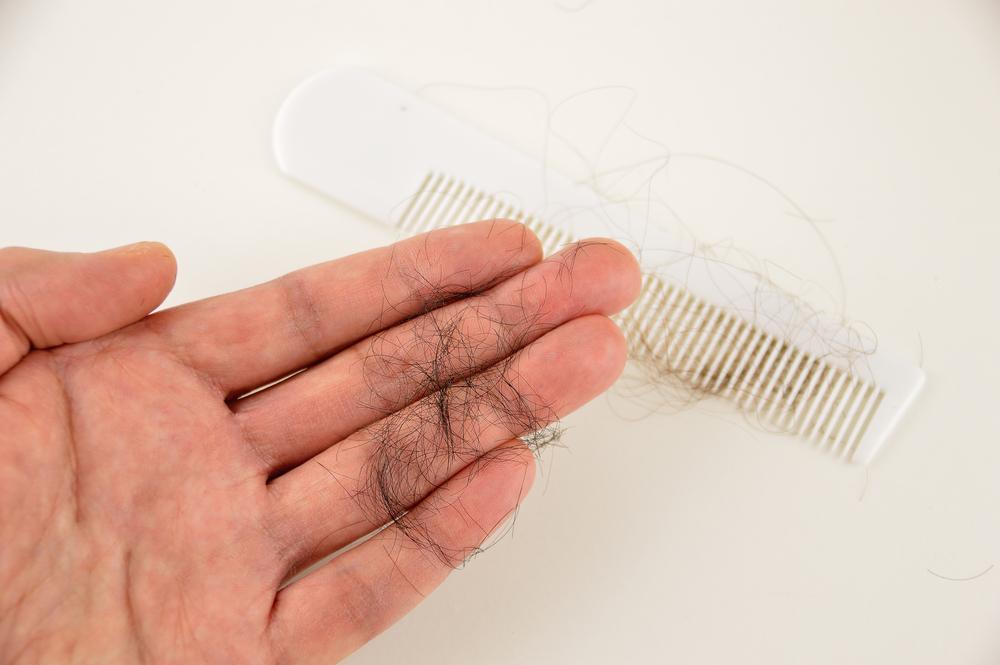
Consider when you get work done on your car or have any work done around your house, one of the first questions you’ll be tempted to ask is “How long is this going to take?” This question will likely remain the same when you go into your doctor to ask about your hair loss and hair re-growth. Even though you understand that hair loss happens over time — you want your hair to grow back, and you want it back now. Unfortunately, there isn’t an app for that yet, nor a miracle instant cure. However, there are things you can do to help speed up the hair regrowth process.



But, before you can learn how to boost the speed of your hair growth, you need to understand the hair growth cycle.
The hair growth cycle
Hair growth begins at the source: your scalp. Healthy hair is fed by blood rich in nutrients that promote growth. When these nutrients stop flowing to the follicles beneath your scalp, you begin to lose your hair.
There are three stages of hair growth: anagen, catagen and telogen. Learning how to care for your hair and scalp during each phase will create the most optimal conditions for healthy hair growth.
- Anagen Phase – The Growth Phase
During the anagen phase, hair fibers are created through proteins and keratin. The hair follicle will begin to emerge from its pore, while the sebaceous glands produce oil to protect and naturally condition your hair. In people with healthy hair, between 80 and 90 percent of the hair on your head is in this phase at any given time.
Hair loss is caused when this phase is disrupted. A hormone, called DHT, constricts blood vessels and causes follicles to shrink, making it extremely difficult for the hair to grow and eventually halting hair growth. Using a follice detoxifier helps clear clogged hair shaft follicles. For those struck with Alopecia Aerata, using Scalp Med®’s Vitadil®†† keeps blood vessels in your scalp open. This allows oxygen and nutrients to flow into hair follicles, helping to revive the dying follicles and keep nutrients flowing, so that new, healthy hair can grow.
- Catagen Phase – The Transformation Phase
The catagen phase is a short, transitional phase that occurs at the end of the anagen phase. It generally lasts around 10 days but can go as long as two to three weeks. During this phase, your hair follicle will shrink, and a part of it is destroyed. The dermal papilla that nourishes the follicle will break away to rest and rejuvenate. One to two percent of your hair is always in catagen phase.
- Telogen Phase – The Resting Phase
During the telogen phase, your hairs do not continue to grow because the dermal papilla, which supplies the hair with nutrients, is in a resting period. It is during this phase that your hairs will eventually be released and fall out. Your hairs will generally remain in the follicles for three to four months before they are shed. Up to 15 percent of your hair is in the telogen phase and those with healthy heads of hair will shed up to 100 hairs a day.
When this is part of natural shedding, after the hair falls out, the whole process repeats itself at the Anagen phase. But when the growth cycle is disrupted, hair loss, hair thinning and problems with growth occur. If this is part of male pattern baldness, the follicle dies and the hair will not grow back at all. A disruption in the hair growth cycle can also be triggered by improper nutrition, an illness or metabolic imbalances.
There is a condition called telogen effluvium wherein more hair will be shed because of restrictive dieting or high fever. This could cause your anagen phase to be cut short, and more hairs will enter the telogen phase at the same time. If your hair growth cycle becomes disrupted, you might also find that your hair doesn’t grow as long as or full as it used to. This is because the disruption doesn’t allow your hair to stay in the anagen phase long enough to reach your desired length.
The average human head has approximately 100,000 strands of hair and each hair strand can stay on the head between one to six years before it falls out and a new one is created. Here are a few more quick questions and answers:
What is the average hair growth rate?
You’re probably wondering: how quickly does hair grow? The average rate of hair growth varies greatly depending on several factors, but there are a few generally agreed upon averages we can use as a baseline. These rates include:
How fast does hair grow per day? 0.5 millimeters.
How fast does hair grow in a month?0.5 inches
How fast does hair grow in a year? 6 inches
The factors that affect your hair growth rate include age, genetics, hormones, sex and even ethnicity. The aging process will cause your hair growth rate to reduce. As we grow older, the speed at which our hair grows will slow down to as little as 0.1 inches per month.
There is also some proof that men’s hair grows faster than females, although not by much. Studies have found that men’s hair grows about 0.75mm per month faster than women’s hair. The answer to why is testosterone. Testosterone helps men grow hair not only faster, but also thicker, and longer hair.
A person’s ethnicity can also affect their hair growth rate. Studies have found that Asian hair grows the fastest, at about six inches per year. Caucasian hair is next at just over five inches per year. While African hair grows the slows at roughly four inches per year. The different growth rates according to ethnicity are more notable in women than in men.
It’s also believed that hair grows slightly faster in the summer months, but it isn’t enough that you should notice a difference.
If you are experiencing hair loss and feel like your methods aren’t working, remember that hair growth is a slow process and you need to be patient. Your scalp has to get healthy before your hair can grow, and this can take time. It can take up to six months to see a real change when using a scientifically proven method. Below are images of hair regrowth at various benchmarks.
How you can speed up the hair growth process?
There is no single miracle solution to make your hair grow faster, but there are several things you can to that may help speed up the process. Take each with a grain of salt, as no two people react the same to everything, but these are agreed to be hair-healthy tips that can put you in an optimal position for hair growth.
Improve your diet with these vitamins and nutrients:
Your diet is the best place to start when you want to create a healthy hair growth environment. But it’s worth repeating: these foods, vitamins and nutrients will not help your hair grow faster on their own, they can only help create an optimal hair growth environment. That being said, simply improving your diet can actually speed up your hair growth and help encourage fuller, thicker hair in as little as two months. The right mix of proteins, minerals and vitamins for hair growth will help nourish hair follicles through your bloodstream.
A basic healthy diet for hair re-growth should include a balanced mix of B vitamins, vitamin C, Iron, Zinc and high-quality proteins, including fish as well as lean meat, chicken and beans. For a more detailed breakdown, here are several nutrients that can promote healthy hair growth and some foods in which to find them. But the biggest nutrient you should be adding to your diet is Biotin.
- Biotin
Biotin forms a part of the B-complex group of vitamins that help to turn food into energy. Also known as vitamin H, Biotin assists in the metabolism of fats, carbs and amino acids which are the building blocks of protein. This is important, because protein-rich foods are not only great for maintaining healthy hair, but could help you grow stronger hair, quicker.
The suggested daily requirement of Biotin is 30 micrograms, but consuming more can give you a real boost in the growth department. Foods that are naturally high in Biotin include almonds, eggs, milk and cheese, pork, salmon and sardines, and avocado and cauliflower. You can also take is as a supplement.
- Cysteine
The amino acid Cysteine also promotes hair growth. This nutrient is found in poultry, eggs, red peppers, garlic, onions, Brussels spouts, yogurt, oatmeal and broccoli. Cysteine can also be found in supplements.
- Grass-fed Gelatin
Gelatin is pure protein that helps to nourish your entire body, but it’s especially beneficial to your hair, skin and nails. It helps your hair by boosting the production of collagen in your skin, which is essential for strong hair growth as well as a healthy complexion. Foods like low calorie jelly have Gelatin, but Grass-fed gelatin will have the highest concentration.
Beyond nutrition, there are a few strategies you can practice to stimulate hair growth. But first, a quick myth bust:
Frequent trimming will not make your hair grow faster
Hair grows out of the scalp. Trimming the ends does not affect its growth. But regular haircuts eliminate broken or split ends, which helps your hair stay healthy. Get haircuts regularly around every two months, depending how fast your hair grows. See our previous post for more hair growth myth busting.
Massage your scalp
Massaging your scalp helps to increase blood flow, which, as we mentioned before, helps those nutrients get to your hair follicles more quickly. This can be done while you wash your hair, but many sources recommend massaging for up to five minutes once a day for an entire week. It also may help to bend over so blood rushes to your head while you’re massaging, known as the “inversion method,” meaning your heart is higher than your head. By doing this, you should encourage the Anagen phase by stimulating your hair follicles.
You can potentially boost your results even further by using a natural oil like coconut oil.
Cold water
Sometimes, there’s nothing quite like a long, hot shower, but did you know that hot water dries out your hair and weakens hair strands, making it more vulnerable to breakage? Try to wash your hair with lukewarm water rather than hot or scorching hot. This will help to close your pores. To reduce hair loss and frizz, a blast of cold water at the end of your rinse can help close the pores.
Washing your hair in cold water will help protect your scalp from dirt, grease and oil because closed pores are less vulnerable than open pores. When your pores stay closed, your hair will remain stronger and you should shed less hair. It’s a small step that can make a big difference in your hair loss. Speaking of heat…
Don’t use heat tools to style your hair
Everyday heat tools, such as hot irons or even just the hair-dryer, can weaken your hair. Even just altering your routine a day or two a week can dramatically improve the health of your hair. So, consider air drying and letting out your natural hair rather than taking all that time straightening or curling.
And it’s not just the heat — over-styling can also harm your hair. The excessive pulling and tugging on your hair and scalp, especially under conditions of high heat, can break or damage your hairs. You could have a perfectly healthy scalp and healthy hair on the inside, but if you’re causing excessive damage on the outside because of over-styling, you may never grow the thick or fast hair you crave.
If you refuse to stop using heat products, at least modify your routine. You could gently towel and air dry your hair about half of the dying time, and use the hair dryer on medium for the rest. There are also sprays which can help reduce damage. And avoid pulling your hair too tightly if you can help it.
Avoid stress
Stress affects pretty much everything, including your hair growth. Stress hormones contribute to hair loss, so try to avoid stressful situations and try to be as stress free as you can to improve your hair and overall well-being.



